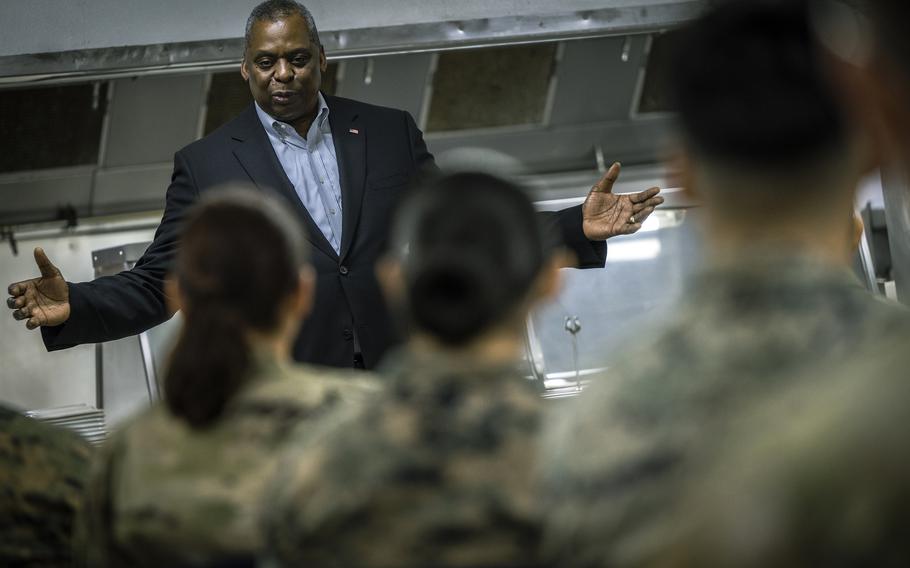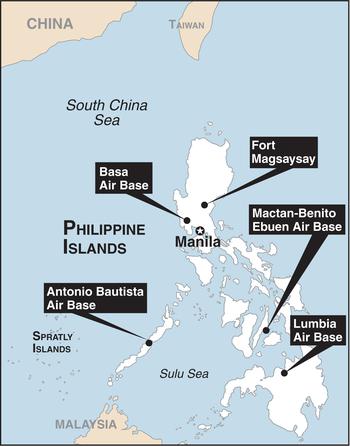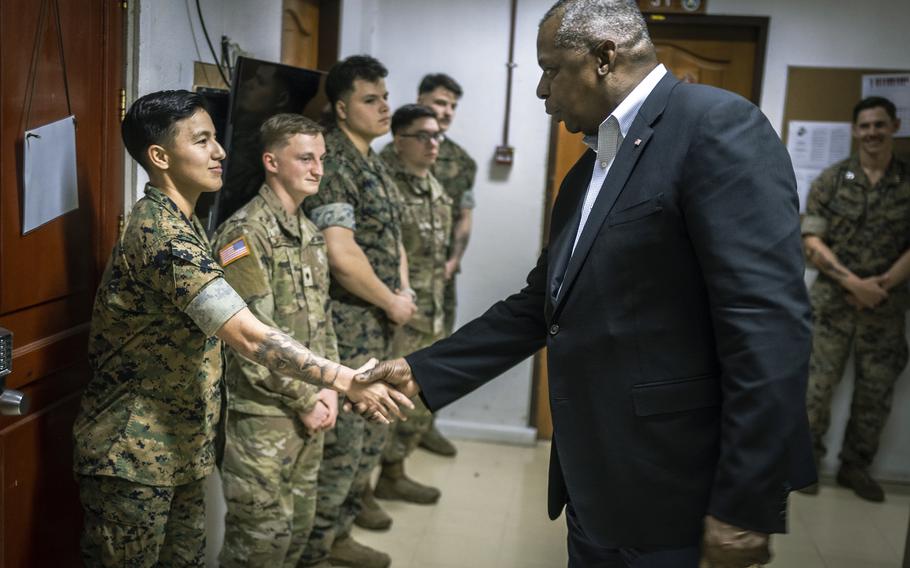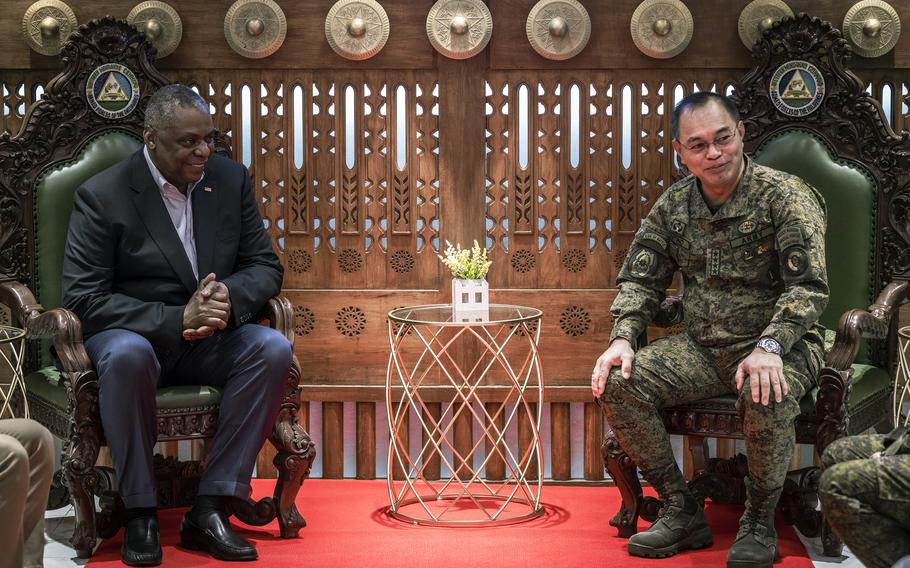
Secretary of Defense Lloyd Austin visits with service members assigned to Camp Navarro in Zamboanga, Philippines, Wednesday, Feb. 1, 2023. (Chad McNeeley/Department of Defense)
U.S. troops will have access to four more military sites in the Philippines under plans announced by the two countries on Thursday.
The agreement marks a turn in the allies’ relationship under a new Philippine president after slow progress during the administration of former leader Rodrigo Duterte, who had sought closer relations with China.
The U.S. and the Philippines agreed Thursday to “accelerate the full implementation of the Enhanced Defense Cooperation Agreement” by completing projects at five locations named in the agreement and adding the four new sites, according to a statement from the U.S. Department of Defense.

(Noga Ami-rav/Stars and Stripes)
Work has been underway, since the defense agreement was announced in 2014, to build facilities for U.S. forces at several previously announced sites in the Philippines. Those five locations are Antonio Bautista Air Base in Palawan; Basa Air Base in Pampanga; Fort Magsaysay in Nueva Ecija; Mactan-Benito Ebuen Air Base in Cebu and Lumbia Air Base in Cagayan de Oro City.
A few dozen leftist activists held a noisy protest Thursday and set fire to a mock U.S. flag outside the main military camp where Defense Secretary Lloyd Austin held talks with his Philippine counterpart. While the two countries are allies, leftist groups and nationalists have protested boisterously for decades against any U.S. military presence in this former American colony.
The four new sites will not be revealed before a consultation process is completed, Philippines Defense Secretary Carlito Galvez Jr. told reporters during a press conference alongside Austin.
“We are not seeking permanent basing in the Philippines,” Austin said. The agreement is about rotational activities, humanitarian assistance and disaster relief, he added.
Forces using the sites could assist in other crises, not just for the Philippines but for the region, according to Austin.
The defense secretaries reaffirmed their alliance, Austin said, noting that it applies to attacks on either nation in the South China or the West Philippine seas.
“These efforts are especially important as [China] continues to advance its illegitimate claims in the West Philippine Sea,” he said.
The EDCA agreement is a key pillar of the U.S.-Philippine alliance, which supports combined training and exercises and helps forces from the two countries work together, according to the DOD statement.
“Expansion of the EDCA will make our alliance stronger and more resilient, and will accelerate modernization of our combined military capabilities,” the statement said.
Adding bases to the agreement will allow more rapid support for humanitarian and climate-related disasters in the Philippines, and allow forces to respond to other shared challenges, according to the statement.
Under the defense cooperation agreement, the U.S. has allocated over $82 million toward infrastructure at the existing five sites, according to the DOD.
The U.S. and the Philippines have committed to move quickly in agreeing to the necessary plans and investments for the new and existing locations, the statement said.

Secretary of Defense Lloyd Austin greets service members assigned to Camp Navarro in Zamboanga, Philippines, Wednesday, Feb. 1, 2023. (Chad McNeeley/Department of Defense)
The U.S. in 2015 requested access to eight bases in the Philippines, including Subic Bay and Clark Air Base, Carlyle Thayer, an emeritus professor at the University of New South Wales and lecturer at the Australian Defence Force Academy, told Stars and Stripes for a Sept. 9 report.
Subic and Clark formed America’s largest overseas military community before both were damaged in the 1991 eruption of Mount Pinatubo and soon after returned to the Philippines.
Duterte, whose six-year term ended in June, had excluded Clark and Subic from the EDCA and threatened to withdraw from it, Thayer said.
U.S. military planners focus on the Philippines as they consider dispersing their forces among small islands in the Western Pacific and size up the prospect of a conflict over Taiwan.
For example, members of the Marine Corps’ newly formed 3rd Marine Littoral Regiment practiced the tactics of expeditionary advanced base operations during the annual Balikatan drills in the Philippines in April.
The Philippines’ new president, Ferdinand “Bongbong” Marcos Jr., son of the country’s late dictator who ruled from 1965 to 1986, “doesn’t have the anti-American chip on his shoulder that Duterte had,” Thayer said. “It is difficult to imagine the Philippines refusing a request from the U.S. for access if a major conflict broke out between China and the US over Taiwan.”

Secretary of Defense Lloyd Austin meets with his Philippine counterpart, Gen. Andres Centino, at Camp Navarro in Zamboanga, Philippines, Wednesday, Feb. 1, 2023. (Chad McNeeley/Department of Defense)
“Having more points to preposition equipment and to operate from gives the US more flexibility and options in the event of a contingency in East Asia … around Taiwan, the South China Sea, East China Sea, or the Yellow Sea and Korean Peninsula,” Ian Chong, an associate professor of political science at the National University of Singapore, said in an email Thursday.
The new sites can provide support to the Philippines if it faces a crisis in the South China Sea or internal unrest, which it experiences from time to time, he said.
“Some of this thinking on the part of Manila may be informed by ongoing [Chinese] pressure on disputed areas of the South China Sea and [Chinese] military activity targeting Taiwan, but near the Philippines,” he said. “Manila has been trying to navigate these concerns along with the attractiveness of economic cooperation with Beijing. This move seems be the latest in the effort to calibrate.”
However, the arrangement involves risks, Chong said.
“Bases or positions in the Philippines could become targets in the event of a confrontation,” he said.